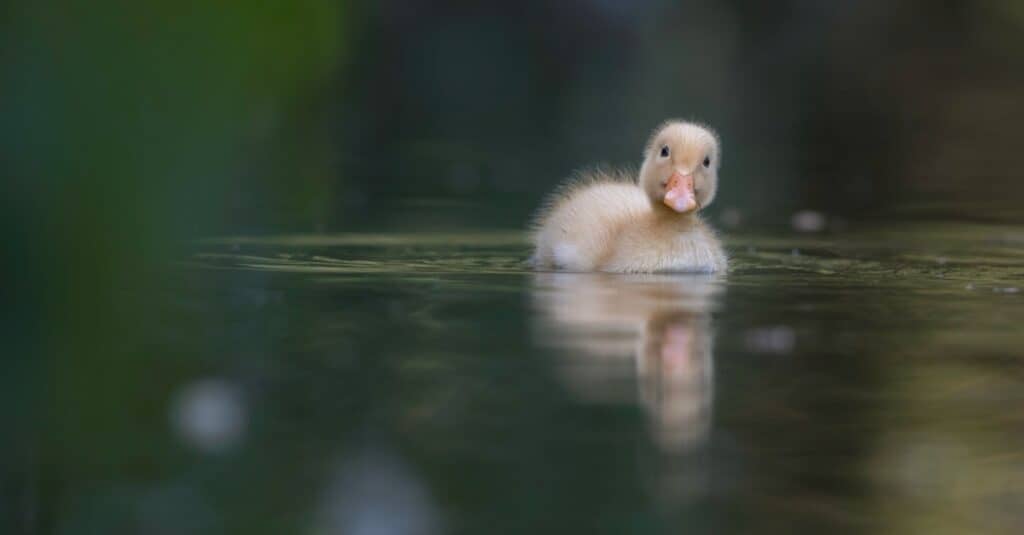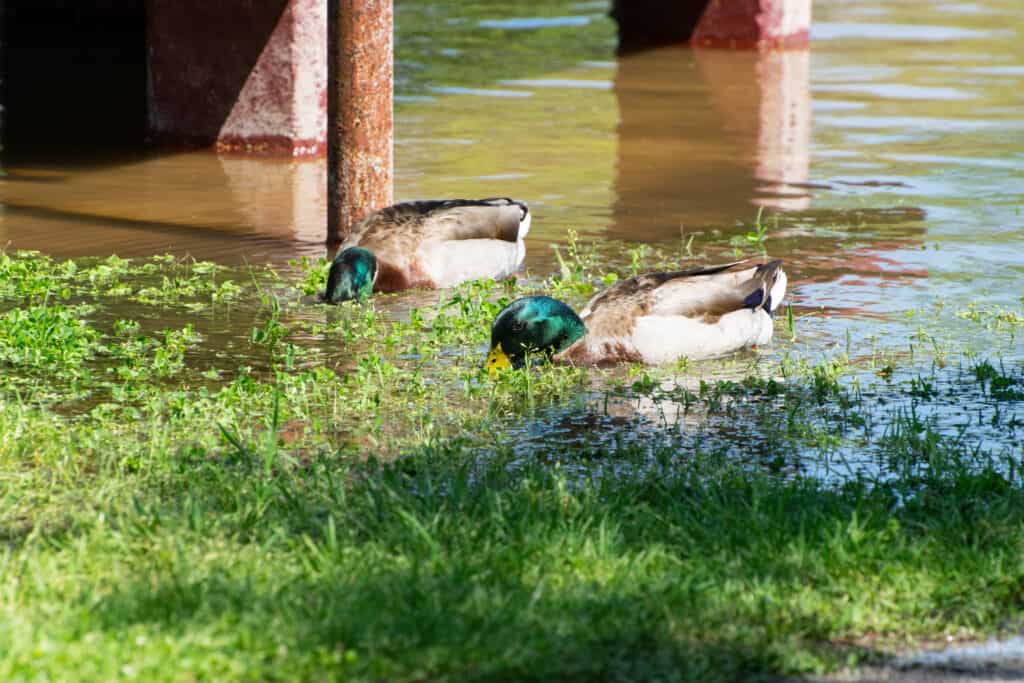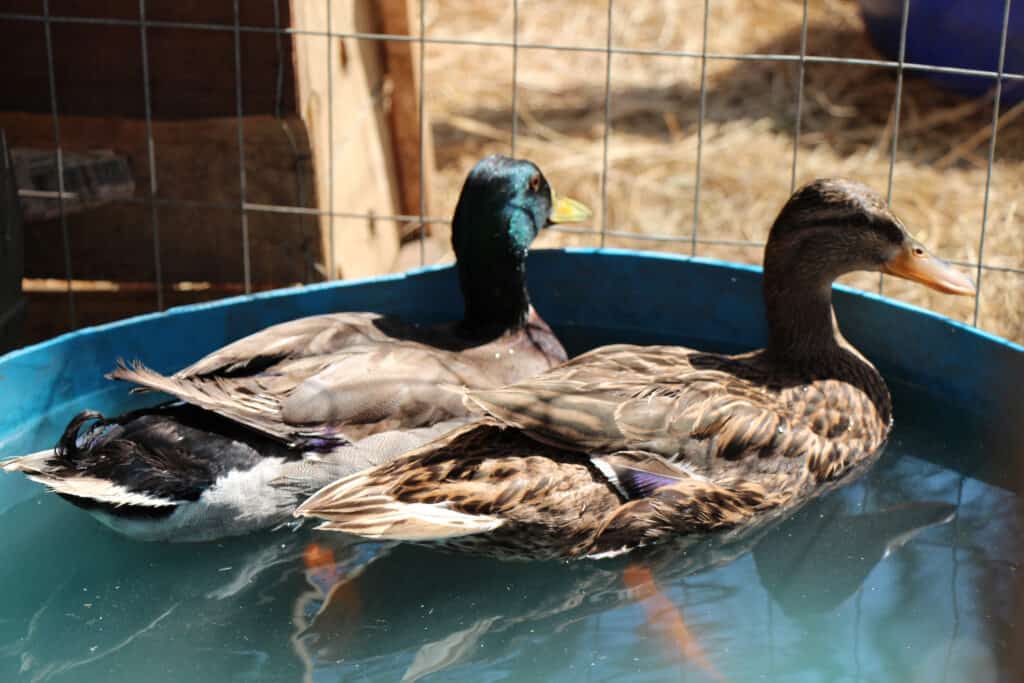Depending on local climate conditions, wild ducklings typically hatch between March and July in North America. Most ducklings don’t require assistance. However, if you encounter an injured or abandoned one, you can take these five steps to care for the baby duck. Millions of ducks call North America home – each species sporting a different color pattern, shape, and size. With so many duck species living in North America, your chances of crossing paths with ducklings are high.

Ducklings typically hatch between the months of March and July in North America.
©iStock.com/Stanislav Ostranitsa
Many North American duck species make epic journeys between breeding and wintering grounds. They follow ancient routes known as flyways, which span thousands of miles across North America. Ducks live in many habitats but prefer bodies of water like lakes, ponds, rivers, and wetlands. They play an essential role in wetland ecosystems by controlling insects, dispersing seeds, and eating invasive aquatic and plant species. Baby ducks can’t fly for several weeks after hatching, making it difficult for them to avoid dangers. Follow these five steps if you encounter a duckling that needs help.
Step 1 — Observe
Before rushing in to rescue a baby duck, it is crucial to consider duck behavior. If the duckling is not in immediate danger, observing the duckling’s situation for some time is the best approach. You can assess its needs by asking the following questions.

Ducklings need to be part of a flock for their social and physical well-being. Lone ducklings might be lost.
©iStock.com/Nick Hurst
Is the Duckling Injured?
Capturing a duckling will cause it to feel stressed, so it is best to assess the severity of the injury. Minor cuts can heal on their own. However, if the cut is ½ inch or larger, the duckling needs help. Other signs of illness or injury include limping, severe lethargy, or drooping wings. You can take steps to contain the duckling if the injury is severe.
When a mother duck is severely injured or killed by a predator, you may not need to assist the ducklings. If the ducklings are old enough to swim on their own, are foraging for food, have some regular adult feathers, and are not being attacked – their best chances are to stay in the wild. Other adult ducks in the area often adopt ducklings. If you come across a lone duckling, wait to see if it joins a nearby group or starts following an adult duck. If the mother needs assistance, it is okay to take her to a wildlife rehabilitator and leave the ducklings in their natural environment.
Is the Duckling Orphaned or Abandoned?
Coming across ducklings that seem to be on their own can be worrisome. However, the mother duck might be close by. It is best to watch at a distance for a while to see if the mother returns. Ducklings typically stay with their mothers for six to eight weeks but start exploring alone before then. If the mother is dead, doesn’t return after several hours, and the ducklings are covered in downy baby feathers, these are indications that the ducklings might need assistance.

Wild ducks often adopt lost or abandoned ducklings.
©iStock.com/Anolis01
Step 2 — Call a Wildlife Rehabilitator
After observing and identifying an injured or orphaned baby duck, the best next step is to call a wildlife rehabilitator who can guide you through actions to take. Wildlife rehabilitators use humane capture and restraint techniques to bring animals to a safe location. They evaluate wounds and seek the help of a professional vet when needed. Plus, they provide a safe, clean environment for the animals in their care. Rehabilitators keep detailed records of each animal they are treating. They create a plan for releasing wildlife back into their native environment or they find a sanctuary when needed. In addition, they are responsible for ensuring animals receive the best nutrition for their species.
Contacting a rehabilitator means the baby duck will be with someone who can take care of the duckling. They know how to clean wounds, provide an appropriate enclosure, administer fluids, and give medications when needed. Most rehabilitators also try to put rescued ducklings into social groups with other ducklings – an essential element in their healthy development. Ducks are social animals and benefit from growing up with other ducklings and being released as a flock.
How Can I Find a Wildlife Rehabilitator?
The best place to find a wildlife rehabilitator is to search online for a local animal rehabilitation directory. You can also check with your local wildlife agency, veterinarian, humane society, or city animal control officers. Here’s a list of online resources for finding wildlife specialists.
- NWRA, the National Wildlife Rehabilitators Association, supports the profession of wildlife rehabilitation with training and educational articles and maintains a database of licensed rehabilitators in the United States.
- Animal Help Now is an online resource for finding assistance with wildlife emergencies in the United States.
- IWRC, International Wildlife Rehabilitation Council, provides education and resources on wildlife rehabilitation and maintains an international database of wildlife rehabilitators.
Step 3 — Catch and Contain
Container
When you are ready to catch a duckling, you will want to have some supplies nearby. Most importantly, have a medium-sized box or tote on hand so that you don’t have to handle the duckling for an extended period, which can increase its distress. High-sided cardboard boxes, shoeboxes, totes, or animal carriers work well. Line the container with towels or paper towels. Puppy pads also work well for ducklings. Avoid newspaper or other smooth surfaces, as the ducklings can easily slip. You should also avoid using hay or straw, as it can harbor mold spores that harm a duck’s respiratory system.
Catching a Duckling
Catch the baby duck by covering it with a light sheet or t-shirt. Then, gently pick the duckling up with the material and place it in a box or container. Take care to handle the baby duck loosely, leaving plenty of room for them to move around in your hands. A duck’s respiratory system is complex – air sacs are located all around their bodies, which are susceptible to injury when squeezed.
Heat Source
Ducklings need a heat source they can snuggle against or move away from if they get overheated. A hot water bottle works best. However, in an emergency, you can fill a water bottle with hot water, wrap it in a paper towel, and place it in the container with the duckling. Make sure that the container you use does not leak. The best way to take care of a baby duck that is to keep it warm and dry.
Food and Water

Wild ducks eat a varied diet by foraging for plants, bugs, grains, small fish, and invertebrates.
©Photography-by-Stretch/Shutterstock.com
In an emergency, you can offer a duckling a source of protein like cooled hard-boiled eggs, mealworms, or canned cat food mixed with a grain like chopped oats. Moisten the grains so that they are easy for the duckling to swallow. Small jar lids work well as a feeding dish. In the wild, they would forage on aquatic plants. To simulate this behavior, you can offer them chopped garden greens in a small water bowl. Eventually, if extended care is needed, ducklings benefit from eating a non-medicated duckling starter feed.
Ducklings need a constant supply of fresh water. Provide a shallow dish of water. Ducklings like to splash and play in their water, which means their water dish often tips over. One way to prevent this is by placing a large rock in the water dish to help weigh it down. Ducks are curious eaters, so make sure the rock is large enough that the duckling can’t swallow it. Ducks need water when they eat, so never provide food without water.
A Quiet Place
Choose a quiet spot to keep the duckling. They have a routine of eating, drinking, preening, then napping every hour. Ducklings grow quickly and need plenty of rest for healthy development. And, if the duckling is injured, it may need more rest than usual. Pick an area where they are safe from other pets and can rest as often as they need.
Step 4 — Research Local Laws
If your efforts to find a wildlife rehabilitator come to a dead end, you might be responsible for raising the rescued duckling yourself. Each state has a different set of laws for raising waterfowl. In addition, each state will have a list of native and migratory species that are protected. Some duck species, like Mallards, span the domestic and migratory waterfowl categories. Local avian wildlife rehabilitators or state wildlife agencies are excellent sources of information about local laws.
Before committing to taking care of the baby duck you encountered, you will also want to check your county or city ordinances and your neighborhood association rules if you live in a community with a neighborhood association. Some cities or neighborhood associations have laws or policies against raising poultry and waterfowl. You can avoid fines by checking in with your local jurisdiction.
Step 5 — Extended Care Plan
Your search to find a place for your rescued duckling might result in the realization that you are the one who will give it a home. Long-term considerations for ducks include shelter, water for drinking and swimming, protection from predators, nutrition, and socializing. In general, ducks are easier to care for than other birds when you give them what they need. Here’s a checklist of things to consider when setting up a permanent home for a duck.

If you care for the injured or abandoned duck you encounter, it will need a small pool for bathing.
©iStock.com/smrials
- Heat — Baby ducklings need supplemental heat until they are fully developed. You can purchase a brooder lamp online or at local feed stores. The general rule is to position the heat source to provide an area that is 90° Fahrenheit, then decrease the temperature by 5 degrees every week until they are 6 weeks old and have adult feathers.
- Shelter — Ducklings can live outside between 6 and 8 weeks old. They need a predator-proof enclosure with a simple coop for nesting and sheltering from wind. Small dog houses or wood barrels lined with wood shavings work well for ducks.
- Nutrition — Ducks have different nutritional needs than chickens and should be given non-medicated duck pellets or starter feed when possible. Add chopped garden greens to a water bowl to aid their natural foraging behavior. Letting your ducks forage in a garden for bugs and plants is a healthy practice, as filtering through the soil will also give them needed grit in their stomachs.
- Water — Ducks need water for swimming and clean drinking water. Once they are old enough to produce waterproofing oil for their feathers, you can provide a small trough or large water container to splash and clean themselves.
- Companionship — Ducks are social animals and need companionship. Ideally, you should raise a duckling with at least one other duckling. Alternatively, you can raise a duckling with a baby chicken or provide it with a mirror, a cuddly stuffed toy, and a lot of human interaction.
Summary of Steps to Take When Caring for a Baby Duck
| Step | Action | Details |
|---|---|---|
| 1 | Observe | Watch the duckling from a distance to see if its mother returns – determine if the mother has abandoned it, or if it is badly injured. It may not need help. |
| 2 | Call a Wildlife Rehabilitator | Check with your local wildlife agency, veterinarian, humane society, or city animal control officers to get contact information for Wildlife Rehabilitators in your area. |
| 3 | Catch and Contain | Use a lightweight sheet or t-shirt to cover and gently pick up the duckling. Place it in a medium-sized container with high sides and provide a source of heat, fresh water, and food. |
| 4 | Research Local Laws | Check on county or city ordinances, your neighborhood association rules, and native and migratory species laws for your state. Determine if it is legal to raise a rescued duckling in your neighborhood. |
| 5 | Extended Care Plan | If all efforts to get the duckling professional help fall through, create an extended care plan including a heat source, nutritional needs, water, an appropriate enclosure, and socializing. |
When a Duckling Doesn’t Survive
Rescuing a baby duckling doesn’t always mean you will save its life and raise it to adulthood. Sometimes, ducklings die despite receiving help. If the mother senses something is wrong with the duckling, she may abandon it. Losing a duckling while attempting to rescue it might indicate that there was an unknown underlying condition. It can feel devastating to find a dead duckling. However, you can feel comforted knowing you gave it the best chance of survival by following the steps in this article to care for the baby duck.
The photo featured at the top of this post is © iStock.com/Wheatfield
Thank you for reading! Have some feedback for us? Contact the AZ Animals editorial team.






